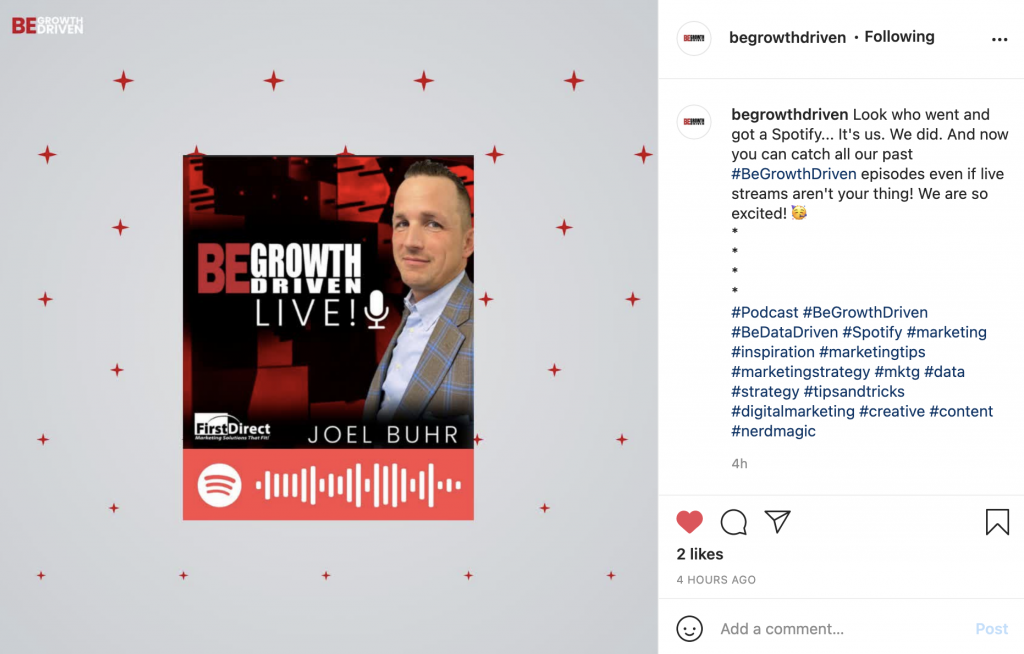4 Internet Marketing Terms You Are Probably Using Wrong
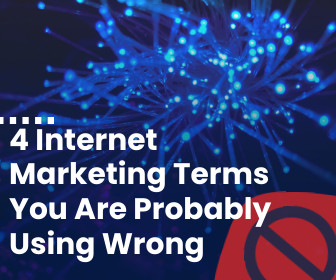
The internet and the marketing industry have something in common: They are full of terms and acronyms that can feel like an entirely different language. It can be super easy to misunderstand and/or misuse those terms. Here’s 4 “marketing/internet jargon” terms you are probably using wrong!
- Viral ≠ more views than you normally get
- Meme ≠ a picture with words on it. Please stop doing this
- Clickbait ≠ a catchy title
- Landing page ≠ a web page you’ve landed on
What do these words actually mean and how can you use them to communicate more effectively what you actually mean?
#1 Viral
What does it mean when you go viral? What makes something viral can be hard to quantify. There’s no magic number that means something is quote-on-quote viral. (Although MANY people try to make one.) Instead of defining viral by the numbers, it’s easier to quantify it by 2 things: reach and speed. The Wikipedia article on viral internet content makes the analogy that viral content is very similar to a virus. Viral internet content self-replicates and quickly spreads far from its original source. And often when content goes viral, it takes on its own life separate from what it was originally intended to be.
Let’s say one of your posts gets double or trip the amount of reach it normally gets. Is that viral? That’s very exciting, but no. Sorry! Although it’s possible to have something go viral with a specific community, viral implies exposure far outside it’s intended audience’s reach. With the number of platforms, and the cross-contaminating reach of those platforms, the general rule of thumb is over 2 million views in less than a few days to call something “viral.” This doesn’t mean that the content has to be a week old, it has to do with rate of expansion.
#2 Meme

This is one of my biggest pet peeves. It can be easy to look at a meme and think that any picture with words on it can be called a meme. It can be, but that doesn’t mean that it is. Meme was coined in 1976 by Richard Dawkins in his book on Darwinian evolution as an attempt to explain memetics; or, how ideas replicate, mutate, and evolve. What makes something a meme is not what it is, but instead the way that it replicates.
For example, the Star Wars “For the better, right?” meme has been a common format to use this month. What has made it a meme isn’t the original movie quote, or the format itself. It is a meme because many people are using or repurposing the format to convey information. Memes are only effective if the format conveys emotion or a message without it being explicitly stated and in a variety of different situations.

Although the types of memes we think of are usually in a concise image-based format, things like folk tales, urban legends, and chain letters are all versions’ memes. They are structured format in which information is shared and evolves.
#3 Clickbait
Are all catchy titles or hooks clickbait? No. The technical definition of clickbait is any text that is designed to entice a user to click or read on. However, the expression has a more specific connotation than that. It implies that the title isn’t accurate and is somehow disconnected from what you will see if you click. It’s similar to old school bait-and-switch marketing. Using bait or a hook isn’t wrong if you are looking to attract people, HOWEVER, the switch is wrong.
Clickbait is sensationalized content. An article titled “5 money making secrets you need to hear,” isn’t click bait if the article is actually about 5 money making tips. Which is part of what makes cracking down on malicious clickbait tricky. A lot of platforms like Facebook and YouTube measures in place to mark clickbait as spam. But how can AI decide if those 5 money making secrets are tips and tricks you actually need to hear? How does the platform know if those “secrets” can actually make you money? Clickbait is connected to consumer perception.
#4 Landing Page
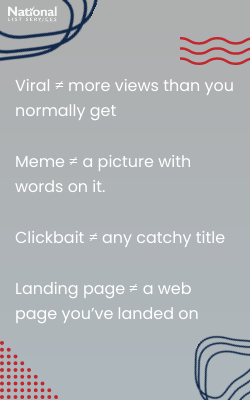
If you land on a webpage does that make it a landing page? No, because a landing page is a webpage you land on that is designed with a specific purpose in mind. One person illustrated it this way: You could use a baseball glove to retrieve a hot dish from the oven, but that doesn’t make your baseball glove an oven mitt. So just because someone lands somewhere doesn’t mean that it is a post-click landing page. The landing page could be designed get the user to make a purchase or fill out a form or watch a video. It doesn’t matter what the purpose is, it matters that it has one.
What is the advantage of separating your landing pages out to specify a single action? Research has shown that companies using 40 or more single action post-click landing pages generate 120% more leads than those using less than 5!
Do you have any marketing/internet terms misuse pet peeves?
Your Marketing Needs These 9 Videos
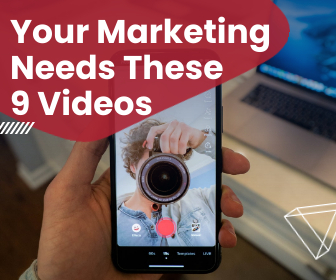
Did you know that are NINE types of videos your business needs? Gone are the days when the only video advertising was television commercials. Now, video is ever-present in our lives. For example, over 2 BILLION users log into YouTube every month. Just like any other tool available, as a business, your brand is going to need different things from different types of videos. Are you using all the kinds of video?
Since different types of videos are used for different things, it’s important to have a well-rounded video strategy. One that helps attract customers, educate them, converts, as well as creates customer engagement and builds relationships. Some types of videos that do that are webinars, promos, digital display, social content, and personalized videos for customers. Some of those are best when heavily scripted and polished, others are great when they feel quickly thrown together. What you need depends on what need you are trying to fill and where the target viewer is on their customer journey. It also depends on how much time, effort, and/or money to pour into video creation.
Explainer Videos
Explainer Video are quick 30-60 videos that explain who you as a company are. It’s basically a pitch video. They great for top of funnel interactions where you need to introduce yourself to potential customers and convince them why they should care about you. They work best when they are made with the audience in mind and feel personal. Don’t forget a strong call-to-action!
You can use Explainer Videos on your website, (think homepage videos) on social media, including YouTube, as well as in ads.
How-To Videos
How-to videos are great for any point of the funnel, can be just about any length, and be used for anything other than ads. However, they don’t need to be extremely high quality or super polished. A real person-to-person feel is more effective. The point of a how-to video is to explain something in a way that will provide valuable content to your audience. This is not the time for a hard sell.
How-to videos are super engaging online because it can feel like pulling back the curtain and letting your audience in on trade secrets!
Promo Videos
Promo videos are basically the general term for commercials. Think short, polished, story driven, exciting videos with strong call-to-actions. They can be used anywhere you need to promote something!
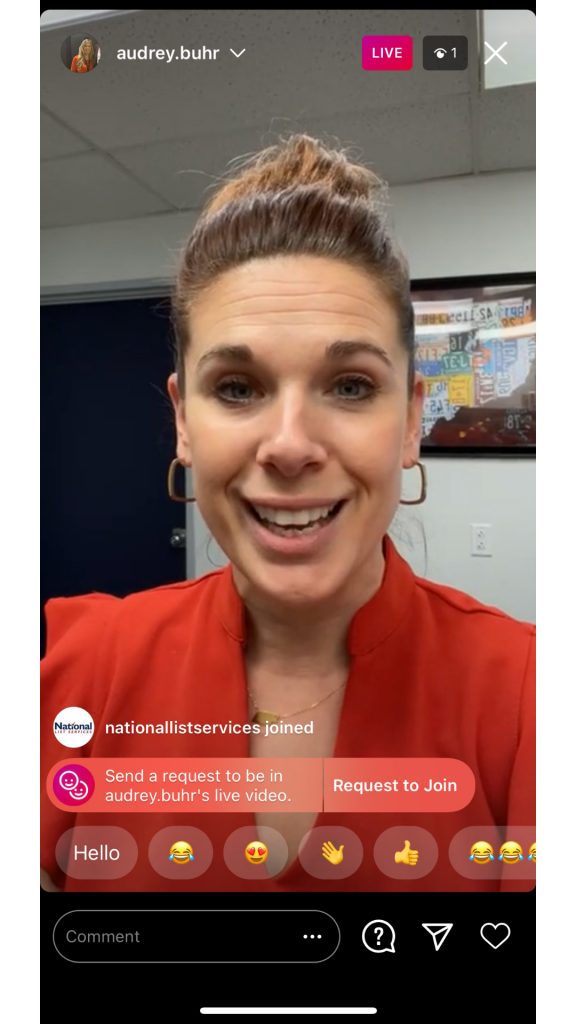
Talking Head Videos
Talking head videos could also be categorized as thought leadership videos. These videos are when you put yourself in front of the camera and share your personality and point of view. These are not designed for a hard sell but instead to show viewers your authentic self and brand personality. Talking head videos work best on social media and on YouTube.
Webinars
I’m going to include podcast videos here as well, (like the video recordings that most podcasts film while recording.) Webinars are inherently educational and therefore the focus needs to be on providing content for your viewers, not selling them. Most webinars are between 15-60 mins. And like in person seminars, they can take many forms: live Q&A’s, lectures, or panels.
Hosting a webinar takes a bit of IT knowledge so it’s totally ok to use a hosting service! It’s a good idea to have a moderator (and maybe an A/V guy) on hand for any troubleshooting or technical difficulties. After the webinar is finished you can make it available for on-demand viewing, as well as cutting the webinar up into smaller clips.
Case Study Video
A case study tells the story of how a real customer uses your product. It provides validation from a third party. Case study video work best when they are clearly planned out and polished. Include the customer/video star on the planning process, that will make the video more authentic. Focus the video more benefits rather than features and back up the information with data.
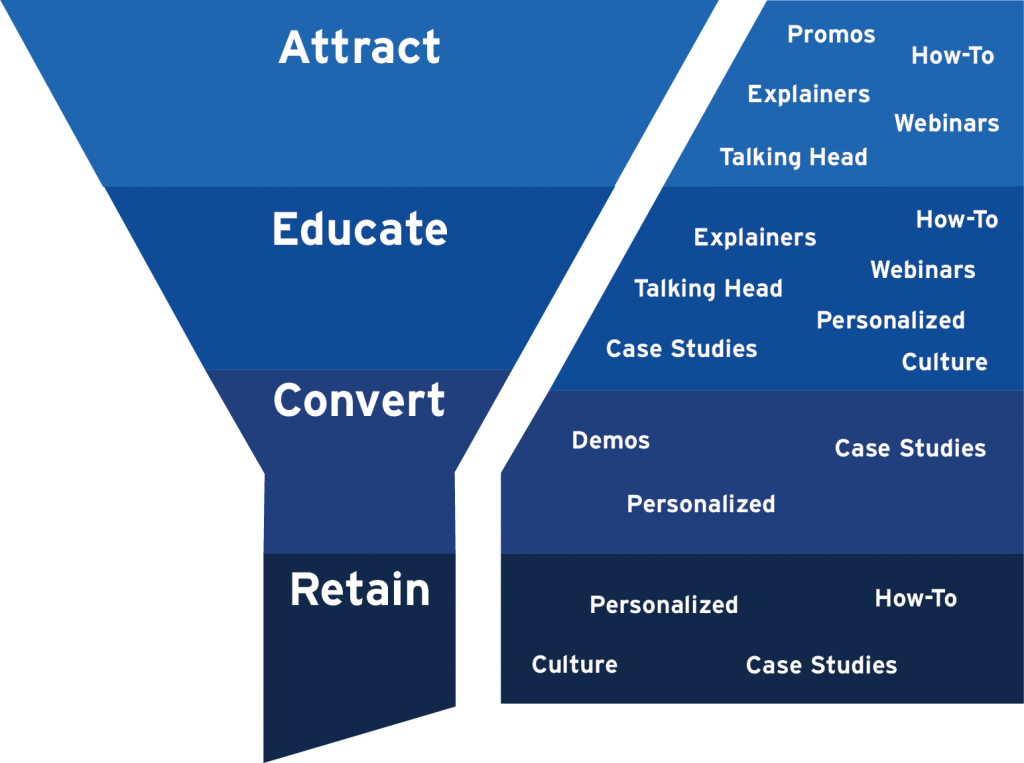
Fun/Culture Videos
These videos are a way to highlight your company’s culture and personality. They help tell your brand story and personality. Often these videos are narrative driven, fun, and humorous. A good example of culture videos is pretty much every company’s TikTok. They are quick and fun and feel personal.
Demo Videos
A demo video is a video that highlights how a product or service actually works. It’s there to educate and inform viewers. Keep the video as concise as possible. They can take a few forms: a broad overview, pre-recorded demo, or live demonstration. For example, we have broad overview demos of National List Services on YouTube, we prerecord demos to onboard clients or answer technical questions, (Loom is great for this) and we often do live demos when showing potential clients how our systems work.
Personalized Videos
Who doesn’t love a personalized video? Sending videos instead of texts or emails to clients is a big part of our follow up. It’s so much more touching to see someone’s face and hear your name than just a written follow up. Because of the nature of our business there are some clients we have never actually met face to face and sending them a personalized video can help bridge that gap.
So, with so many avenues and different types of videos, it’s easy to see why it’s such a popular marketing tool. How do you use video in your marketing?
Scared of Content Creation? Here’s 6 tips

Content creation is an integral part of marketing or running a business in general now. Even if you don’t think that you are a quote-on-quote content creator, you probably do create content. Every time you post on Facebook or update Instagram, that’s content. What are some easy things you can do to up your content game?
Here’s 6 things we have found to be essential in making quality content!
Know Your Audience
The content you create for one audience can be very different from another. Understanding the WHO is helpful first step.
It can also be helpful if you think of your audience as a single composite person. Instead of trying to talk to all of them, you are instead making content for one person. A lot of companies do this by making a buyer persona. That way you can think, “Would my buyer persona like this?” vs. “Would all my followers enjoy this content?”
Make a Plan
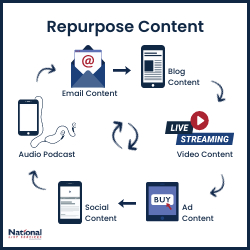
There is nothing more overwhelming than trying to maintain consistent content posting across multiple channels without a plan. It can feel like juggling snakes. 🐍 Making a plan can be as simple as figuring out what types of content you want to post and when it would be best to time to post it. The more specific your plan is the more you time you take out of the equation.
Part of making a plan is planning out your message and/or your angle. Now that you know who your audience is, think about what type of content would work best for them. Knowing what you want to talk about can make it easier to figure out what types of content would be best. Would your audience benefit from long form blog articles or would a TikTok series be more helpful? Both of those types of content take a lot of effort, so planning it out ahead of time is valuable!
Keep It Simple and Honest
Don’t make it harder than it needs to be. No matter who your audience is, needlessly complicated language or content structure isn’t appreciated. Simple and honest is always good. Remember, why you are making the content. Is it to promote you or your brand? Then tone of the content should match your voice. People can see right through any inauthenticity if you are trying to make something that isn’t you.
It’s easier to connect with a brand online if you feel like you are talking to a real person. Does the content you are making sound personal?
What is the Purpose of Your Content?
Why do you want to make this content? Keep the big picture of your content in mind as well as each individual piece. Are you trying to promote a specific product or service? Don’t be afraid to include a call to action in your content! A call to action is how to accomplish the goal of your content. It’s the follow through.
A good call to action is simple and concise. It uses strong verbiage. Give your audience a good reason to take the desired action. Don’t be afraid to get creative!
Take a Step Back
When it comes to content, it’s often valuable to take a step back and from your project and let it rest for a bit. The longer you work on a piece of content the easier it is to be become blind to mistakes, errors, and typos. You may be surprised by the power of fresh eyes!
An old copy writer trick is to proofread backwards. Instead of starting at the beginning of your content: start at the end. Because your brain is following a different path through the information, it sees things in a different way. Starting at the end allows you to look at it sentence by sentence instead of word by word or thought by thought. Knowing your content is edited well will help you feel more confident in posting it.
Another aspect of taking a step back from your content is revisiting old content. Repurposing or adapting finished content is an excellent way to stay inspired and make more content. There are always new things that can be added. Adding information keeps your messages up to date. Up-to-date content is more accurate and provides for value to your followers. Another reason to recycle content is that it gives more people an opportunity to see it. And even if someone has been following you for a long time there’s a good chance that they didn’t see the content the first time around.

Keep Consuming Content
This is my favorite part. 😜 One of the best ways to keep your own content sharp is to consume other content. It can inspire you, help you stay up to date with current trends, and keep your skill sharp. Most ideas don’t start in our heads, the spark is external. All of the creative juices it takes to create content can easily be burnt out if you don’t feed it with creative thing that you care about. Change your scenery, have conversations, read books or articles, watch a movie or show. Diversity of other creative inputs will refill your own creativity!
What’s your favorite type of content to create? How do you stay motivated in content creation?
What Do You Need to Create a Successful Podcast?
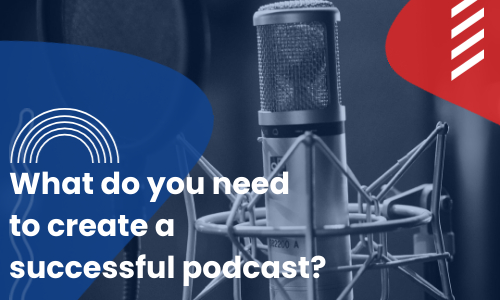
Nearly 51% of adult Americans listen to podcasts!
Here’s the steps you need to create your own successful podcast!
Step One: Get Over Your Fear!
The first step to success is to just start! There’s a lot of fears people have about starting a podcast.
“My voice sounds weird.”
“I don’t have enough technical know-how.”
“The equipment is expensive.”
“A podcast is time consuming.”
Chances are that once you get started, those fears will dissipate!
Step Two: What Do Want To Say?
One of the most important things about starting a new venture, like podcasting, is to have a mission. For example, our podcast, BeGrowthDriven, was started because our mission as a company is to help business grow. We wanted to connect like-minded business and entrepreneurs to share advice and recourses. That goal informs all the decisions we make about the podcast.
How to you want to help your audience or customers? What is the goal of your business? You can expand on that to create your podcast’s mission.
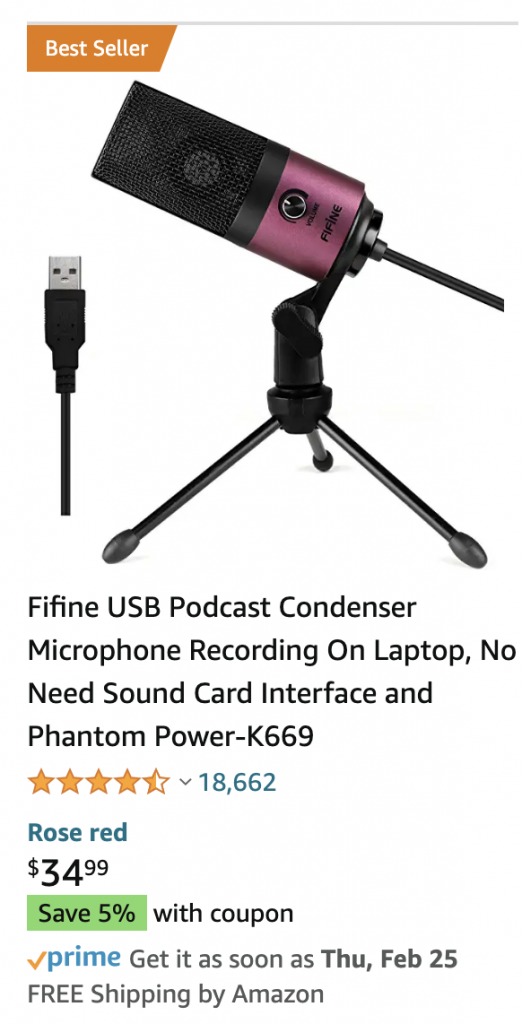
Step Three: Record Your First Episode
You don’t need expensive equipment to get started! (Though podcast mics start at like, $30 on Amazon.) Here’s what tools we have found to be helpful.
Part of recording your episode is the editing and mixing side of things. It’s totally up to you how much editing you want to do! It all depends on what you want the feel of your podcast to be.
Step Four: Publish Your Podcast
There are many directories to publish podcasts on. That big three are iTunes, Spotify, and Google Podcasts.
Doing well on iTunes/Apple Music is the goal. Around 70% of all podcast listens and downloads happen through Apple. It can be trickery to get monetarization on Apple than on Spotify or Google. So, having your podcast available on as many platforms as possible is good idea!
It’s also a good idea to publish three to five episodes at launch to give your new listeners something to listen to.
Step Five: Promote, Promote, Promote
Podcasting has been around for a long time so there are many recourses and tools available for promoting (or learning how to promote) your podcast. Here’s some tips and tricks
- Tap into your guest’s audience
Chances are if they are a good fit to be a guest on your podcast, there audience could also benefit form your content. Make it easy for your guest to share out pull quotes, images, and links from their episode.
- Use social media.
This is kinda a no brainer. Podcasts can be slip into so many different types of content that is easy to post them across many different platforms. Pull quotes do great on Instagram, Facebook, and LinkedIn. Links can be shared on twitter and Facebook. Twitter also has a great SoundCloud integration you can use.
Social media can be used to promote the episode ahead of time as well as sharing past highlights. Social media also is great way to connect with fans and listeners one personal level and add another channel for them to interact with you.
Step Six: Repurpose Content
Podcast content can be repurposed into many other different types of content. We’ve already talked about pull quotes and highlight clips, there’s way more things you can do. For one thing, it’s common place to film the recording of the podcast. That video can be put on YouTube. And video highlights can be put on social media. Putting the video on YouTube also gives you some accessibility features such as closed captioning. Since YouTube is owned by Google, videos on YouTube boost your overall brand SEO which as far-reaching benefits.
Another helpful way to repurpose podcast content is to have the podcast transcribed. If you don’t have time to do that yourself, (understandable: it’s time consuming) companies like Rev.com or Fiverr offer cheap transcription services. Once your podcast is transcribed, it can be used as blog content to make it accessible on another channel and boost SEO.
Step Seven: Get Featured On Other Podcasts!
A great way to promote your podcasts and reach new audiences is to be a guest on other podcasts! The podcast community is well connected and worth tapping into.
Do you have a podcast? We want to hear all about it!

